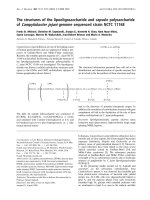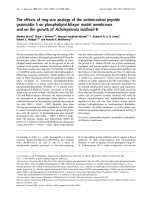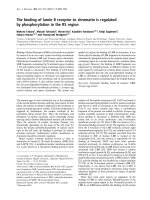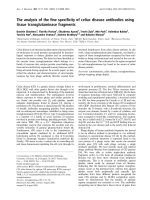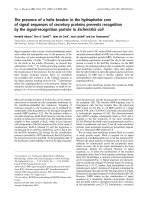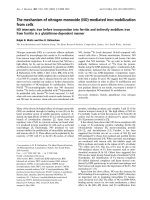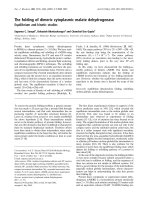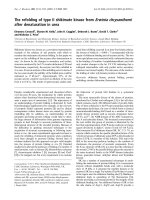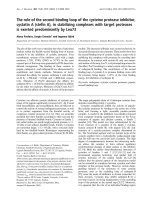Báo cáo y học: "The trauma of ongoing conflict and displacement in Chechnya: quantitative assessment of living conditions, and psychosocial and general health status among war displaced in Chechnya and Ingushetia" pptx
Bạn đang xem bản rút gọn của tài liệu. Xem và tải ngay bản đầy đủ của tài liệu tại đây (303.74 KB, 13 trang )
BioMed Central
Page 1 of 13
(page number not for citation purposes)
Conflict and Health
Open Access
Research
The trauma of ongoing conflict and displacement in Chechnya:
quantitative assessment of living conditions, and psychosocial and
general health status among war displaced in Chechnya and
Ingushetia
Kaz de Jong*
1
, Saskia van der Kam
1
, Nathan Ford
1
, Sally Hargreaves
1
,
Richard van Oosten
1
, Debbie Cunningham
1
, Gerry Boots
1
, Elodie Andrault
1
and Rolf Kleber
2
Address:
1
Médecins Sans Frontières, Plantage Middenlaan 14, 1018 DD Amsterdam, The Netherlands and
2
Department of Clinical Psychology,
Utrecht University, The Netherlands
Email: Kaz de Jong* - ; Saskia van der Kam - ;
Nathan Ford - ; Sally Hargreaves - ; Richard van
Oosten - ; Debbie Cunningham - ;
Gerry Boots - ; Elodie Andrault - ;
Rolf Kleber -
* Corresponding author
Abstract
Background: Conflict in Chechnya has resulted in over a decade of violence, human rights abuses,
criminality and poverty, and a steady flow of displaced seeking refuge throughout the region. At the
beginning of 2004 MSF undertook quantitative surveys among the displaced populations in
Chechnya and neighbouring Ingushetia.
Methods: Surveys were carried out in Ingushetia (January 2004) and Chechnya (February 2004)
through systematic sampling. Various conflict-related factors contributing to ill health were
researched to obtain information on displacement history, living conditions, and psychosocial and
general health status.
Results: The average length of displacement was five years. Conditions in both locations were
poor, and people in both locations indicated food shortages (Chechnya (C): 13.3%, Ingushetia (I):
11.3%), and there was a high degree of dependency on outside help (C: 95.4%, I: 94.3%). Most
people (C: 94%, I: 98%) were confronted with violence in the past. Many respondents had witnessed
the killing of people (C: 22.7%, I: 24.1%) and nearly half of people interviewed witnessed arrests (C:
53.1%, I: 48.4%) and maltreatment (C: 56.2%, I: 44.5%). Approximately one third of those
interviewed had directly experienced war-related violence. A substantial number of people
interviewed – one third in Ingushetia (37.5%) and two-thirds in Chechnya (66.8%) – rarely felt safe.
The violence was ongoing, with respondents reporting violence in the month before the survey (C:
12.5%, I: 4.6%). Results of the general health questionnaire (GHQ 28) showed that nearly all
internally displaced persons interviewed were suffering from health complaints such as somatic
complaints, anxiety/insomnia, depressive feelings or social dysfunction (C: 201, 78.5%, CI: 73.0% –
Published: 13 March 2007
Conflict and Health 2007, 1:4 doi:10.1186/1752-1505-1-4
Received: 18 December 2006
Accepted: 13 March 2007
This article is available from: />© 2007 de Jong et al; licensee BioMed Central Ltd.
This is an Open Access article distributed under the terms of the Creative Commons Attribution License ( />),
which permits unrestricted use, distribution, and reproduction in any medium, provided the original work is properly cited.
Conflict and Health 2007, 1:4 />Page 2 of 13
(page number not for citation purposes)
83.4%; I: 230, 81.3%, CI: 76.2% – 85.6%). Poor health status was reflected in other survey questions,
but health services were difficult to access for around half the population (C: 54.3%, I: 46.6%).
Discussion: The study demonstrates that the health needs of internally displaced in both locations
are similarly high and equally unaddressed. The high levels of past confrontation with violence and
ongoing exposure in both locations is likely to contribute to a further deterioration of the health
status of internally displaced. As of March 2007, concerns remain about how the return process is
being managed by the authorities.
Background
The conflict in Chechnya has resulted in over a decade of
violence, human rights abuses, criminality and poverty.
Since the start of the second war between Chechnya and
Russia in 1999, thousands of civilians have been killed or
have disappeared, all in a climate of impunity.
Years of conflict have resulted in severe destruction of
health infrastructure. Many doctors have left the country,
while those who remain in Chechnya often fear for their
personal safety. Lack of experienced medical personnel,
especially in remote rural districts, is one of the biggest
problems facing Chechnya's health system today.
The last decade of conflict in Chechnya resulted in around
260,000 Chechens being displaced to neighbouring
Ingushetia, most finding shelter in tent camps and collec-
tive squats (Kompakniki) or spontaneous settlements –
farms, sheds, train wagons, and factories. Living condi-
tions in tent camps and spontaneous settlements have
been poor. In a 2003 survey carried out by Médecins Sans
Frontières (MSF) [1], 54% of the families interviewed in
tent camps in Ingushetia stated that their tents leaked, did
not have protection from the cold, or had no flooring in
conditions where temperatures regularly fall bellow -
20°C.
The Ingushetian and Russian governments have increased
pressure on the Chechen displaced population to repatri-
ate. Physical, psychological and administrative harass-
ment, the cutting-off of basic services such as gas, water
and electricity, and intense propaganda about imminent
camp closures, were all used to compel people to return to
Chechnya [2]. 'Repatriation' was pushed forward despite
the fact that people did not want to return to Chechnya
due to the continuation of the conflict and insecurity, and
the lack of proper shelter and adequate health services in
Chechnya.
To inform the future direction of assistance programmes
MSF undertook quantitative surveys among the displaced
populations on both sides of the border – both in the
spontaneous settlements in Ingushetia and temporary
accommodation centres (TACs) housing returned inter-
nally displaced within Chechnya. As a consequence of
poor health infrastructure and limited external assistance,
the health status of internally displaced in Chechnya and
Ingushetia is poorly documented; to our knowledge no
systematic data on the general and psychosocial health
status of this population have been previously published.
Assessment of violence and related health needs
Methods
Two surveys were executed: one in Ingushetia (January
2004) and one in Chechnya (February 2004). A system-
atic sampling method was applied in both locations [3].
Sample size was based on an estimated prevalence of
trauma-related psychological problems of 20% [4], a pre-
cision of 5% (confidence interval 95%), and an assumed
dropout rate (including refusal) of 5%. This gives a sam-
ples size of 257 households in each location.
Official demographic data were used to calculate the sam-
pling interval. In Ingushetia, the population to be sur-
veyed was divided over 143 spontaneous settlements
(tent-like arrangements within empty buildings). The offi-
cial population was 21,901 with an average household
size of 5.3 persons distributed over 4107 households. In
order to arrive at a sample size of 257, a sampling interval
of 15.9 was required (rounded to 16).
In Chechnya, the target population was those living in 20
TACs. According to the authorities approximately 3,520
households were permanently present in the TACs. Given
the average household size of 5.7, the population was esti-
mated at 20,064. In order to arrive at a sample size of 257,
a sampling interval of 13.7 was used (rounded to 14).
In both places the number of interviews per settlement (or
TAC) was proportionally related to the number of inhab-
itants (a logical result of a systematic sampling). The first
household was randomly chosen to start the survey in
each location. The first household for the systematic sam-
ple in the TACs (Chechnya) was chosen randomly by tak-
ing a random number from the sampling interval and
choosing the house with that number. The next house-
holds were chosen according to the fixed sampling inter-
val (14) following a specific direction. Households in the
spontaneous settlements in Ingushetia were not systemat-
ically ordered, so the starting household was randomly
Conflict and Health 2007, 1:4 />Page 3 of 13
(page number not for citation purposes)
chosen by spinning a pen in the centre of the settlement
and the survey started with the first household in that
direction. The next household was chosen in a predefined
circular direction (systematic) according to the sampling
interval (16).
Only people aged 18 or above were interviewed. To avoid
selection bias a coin was tossed before knocking on the
door to determine whether a male or female respondent
would be requested. If the person answering the door was
the opposite gender to that determined for selection, the
interviewer asked whether there was a respondent of
opposite gender and the same age in the household. If no
one of the desired gender was present the person answer-
ing the door was interviewed. If nobody answered the
door the adjacent household was selected.
All interviews were done during the day, with an average
of four interviews conducted daily by each team member.
Interviews lasted a maximum of 60 minutes and for those
participants that needed follow-up support, referral to
professional counsellors was offered.
All participants gave written permission for their partici-
pation. Interviewers respected confidentiality at all times;
guarantees of anonymity were given to each participant,
together with a clear explanation of the purpose of the sur-
vey and the fact that the general findings would be
released publicly. It was made clear to participants that
they would not receive any compensation for participat-
ing in the survey, and that they could decide at any
moment to stop the interview without giving a reason.
Forms were registered anonymously and data were ana-
lysed by EXCEL and EPIINFO-6 using descriptive and uni-
variate analyses.
Instruments
The survey questionnaire was translated from English into
both Russian and Chechen, and then back translated to
English, and differences discussed and agreed on. The
design of the questionnaire was informed by experiences
from other assessments done in acute conflict settings
[5,6]. Triangulation (the use of different sources and/or
methods to verify validity when information is potentially
conflicting or inconsistent [7]) of several conflict and
health-related variables and methods (open-ended ques-
tions, semi-structured questionnaires) were used to get
insight in the suffering and needs of the Chechnen IDPs
in both Ingushetia and Chechnya.
Demographics
General demographic data (age, gender etc.) were
obtained.
Displacement history
Questions on displacement history were asked in order to
seek insight into the collective experience of being dis-
placed and their wishes to leave the settlements and pre-
ferred locations of return.
Living circumstances
Several questions on the availability of water and sanita-
tion, food and physical shelter were posed.
Confrontation with violence
People are confronted with traumatic events in several
ways, including exposure to an event (being in the area
but not witnessing or self-experiencing an event), witness-
ing of an event (seeing the event happen) and self-experi-
ence. All are established risk factors for developing health
(including mental health) problems [8-10]. Generally
speaking the proximity to the event [11-13], the severity of
the incident [14], and the extent of the physical injury
increases the risk of developing health problems. A list of
violent events was developed in close consultation with
the national counselling staff. Both the composition of
the list and the outcomes provide an important testimony
of the collective experience of violence.
A distinction was made between recent (i.e. the previous
month) and past (since the start of the conflict in 1994)
experiences for two reasons. First, it gives insight in the
current security situation. Secondly, it gives an indication
of the number of potentially traumatic events experienced
over time (accumulation) as long-term exposure to vio-
lence is a risk factor for developing health problems [15].
Loss
In addition to questions relating to violence, questions on
the consequences of the conflict such as human and mate-
rial loss were included.
General Health
The General Health Questionnaire 28 [16] (GHQ 28) is a
tool that has been widely used for many years to screen
general health in community settings including those
affected by violence [17]. Four subjective indicators of
health are assessed: somatic complaints, anxiety and
insomnia, social dysfunction, and depressive feelings.
These subscales are not designed to make a specific diag-
nosis for an individual, and are not mutually independent
[18]. However, for assessment of general health of a com-
munity it is helpful to identify subscales that are propor-
tionally higher than others. For each of the 28 items, one
of four answers is proposed: less than usual; usual; more
than usual; and much more than usual (Likert scale).
People suffering from chronic or traumatic stress often
report non-specific complaints such as headaches, stom-
Conflict and Health 2007, 1:4 />Page 4 of 13
(page number not for citation purposes)
ach problems, general body pain, dizziness or palpita-
tions [19,20]. Open questions were used in this survey to
find out the type and order of importance of the subjective
health complaints over the past 6 months (maximum of
four) in order of priority. All answers on these open ques-
tions were then grouped in categories based on preva-
lence. Closed questions were used to gain information
about the availability and accessibility of medical services
and drugs. Answers to these questions were registered
using a Likert scale.
Coping mechanisms
Questions were included that were designed to obtain
qualitative information regarding how the respondents
coped with their problems.
General items
The last section of the questionnaire was used to find out
whether respondents were able to distinguish between
psychiatric disorders and psychological complaints
caused by violence. We included open questions in which
respondents were asked to indicate a maximum of four
signs of each.
At the end of the survey, we asked respondents what addi-
tional support they needed.
Results
In the following reporting of findings, the Chechen Tem-
porary Accommodation Centres (TACs) and the Ingushe-
tian spontaneous settlements (Kompakniki) are shown in
the text by using: 'C' for Chechnya and 'I' for Ingushetia.
Demographics
256 people in Chechnya and 283 people in Ingushetia
were interviewed. None of those approached for inter-
viewing refused and no interviews were interrupted (i.e.
100% completion). The vast majority of interviewees were
Chechen; despite randomisation more females were inter-
viewed then men (C: 70.3%, 180; I: 65.4%, 185). To a
lesser extent females were also over-represented in the
general population (C: 52.5%, I: 55.4%).
Displacement
Displacement mainly occurred in two periods, consistent
with periods of severe conflict in Chechnya: 1994/1995
and 1999/2000. The majority of those interviewed had
been displaced for at least four years and had changed
location between two and five times. Most participants
indicated a wish to return to their place of origin. The two
groups stated different reasons for not returning. For those
living in Chechnya lack of shelter was the main reason for
not returning to their hometown (200, 78.4%) while inse-
curity was less important (25, 9.8%). For those inter-
viewed in Ingushetia insecurity was rated much higher
(139, 49.1%) and lack of shelter (129, 45.6%) was rated
lower.
The main stated reason for those who left Ingushetia to
live in the Chechnen TACs were: the poor living circum-
stances in the spontaneous settlements, homesickness
and the prospect of compensation offered by the authori-
ties.
Living conditions
In Ingushetia, lack of proper shelter (C: 11, 4.3%, I: 108,
38.2%) and inability to keep warm (C: 47, 18%, I: 113,
40%) was reported more frequently than in the Chechnen
settlements. The two sites were equally poor in terms of
toilet facilities (C: 184, 72.4%, I: 255, 90.1%) and food
was a problem for one in ten (C: 34, 13.3%, I: 32, 11.3%)
Almost all respondents were dependent on charity. It
should be noted that while the TACs were intended for
short stay only, a substantial number of people had been
there for one to two years (87, 34.1%, n = 255), or longer
(33, 12.9%).
Confrontation with violence
Month prior to the survey
Nearly twice as many people in Chechnya (C: 171, 66.8%,
I: 106, 37.5%) indicated that they never or only occasion-
ally felt safe (Table 2). A similar difference was found with
respect to exposure to conflict-related violence in the last
month: one in ten people (32; 12.5%) in Chechnya said
they had been affected, reporting over 60 violence-related
events. Most frequently mentioned were: mopping up
operations (often violent operations used by the army to
identify 'terrorists' among the civilian population) (22
occurrences) and to a lesser extent attacks and crossfire
(both more then 8 occurrences). In Ingushetia fewer peo-
ple (13, 4.6%) reported exposure to violence in the past
month (31 violent events). Most of these incidents (25)
were reported as being self-experienced by the participants
(several participants experienced more than one event).
For the majority (18 occurrences) of these cases the per-
son interviewed had been detained/taken hostage.
Since start of the conflict
Exposure to violence since the start of the conflict was
similar for both groups in Chechnya and Ingushetia (C:
241, 94%, I: 5, 98%). The most common events (Table 3)
included mopping-up operations, aerial bombardment,
mortar fire, attack on house or village, crossfire, burning
of houses, and destruction of property.
Respondents from Chechnya and Ingushetia witnessed a
similar number of violent events. More than one in five
witnessed the killing of people (C: 58, 22.7%, I: 68,
24.1%) and nearly half had witnessed maltreatment (C:
144, 56.2%, I: 126, 44.5%). Several people had been wit-
Conflict and Health 2007, 1:4 />Page 5 of 13
(page number not for citation purposes)
ness to torture (C: 14, 5.4%, I: 16, 5.6%). While many
people had heard about incidences of rape (C: 181,
71.1%, I: 204, 72.1%), only a few had witnessed it (C: 2,
0.8%, I: 7, 2.5%).
In Chechnya 88 (34.4%) respondents had personally
experienced violence since the onset of the conflict. In
Ingushetia this was slightly lower, at 80 (28.3%). The type
of self-experienced violence was similar in both locations,
the most frequently reported events being maltreatment,
detention, arrest, and forced labour. Torture and mine
injuries were also reported. Disappearances among mem-
bers of the nuclear family (partners, siblings) affected one
fifth of the interviewees (C: 57, 22.3%, I: 54, 19.1%).
Loss
Material loss
Nearly all respondents reported losing all possessions
including their house (C: 254, 99.2%, I: 268, 94.7%).
Mortality in the previous two months
In Chechnya nineteen participants (7.4%) reported 28
deaths in their nuclear family over the past two months
(see Table 4). Eleven of them (39.2%, n = 28) were
Table 1: Overview of demographic and socio-economic findings
Chechnya Ingushetia
nn
Population
Total population number in TACs, Spontaneous Settlements (official figures) 20,064 21,901
Interviewees (one per household) 256 283
Female interviewees 180 70.3% 185 65.4%
Total number of family members in surveyed households 1107 1668
Average number of family members in surveyed households (official average in population in
brackets)
4.3 (5.7) 5.8 (5.3)
n%n%
Displacement history
Displaced > 4 years 249 98.0% 272 96.1%
-During first Chechnen War (1994–1995) 122 48.0% 104 36.8%
-During second Chechnen War (1999/2000) 118 46.5% 154 54.4%
-Others 9 3.5% 25 8.8%
Displaced < 4 (missing data) 5 (2) 2.0% 11 3.9%
Displaced more than once (2–5 times) 212 83.1% 160 56.6%
Wish to return home 220 86.3% 243 85.9%
Origin
Chechnya 250 97.7% 253 89.4%
Other 62.3%3010.6%
Reason for not returning to place of origin
Lack of shelter 200 78.4% 129 45.6%
Insecurity 25 9.8% 139 49.1%
Other 31 12.% 15 5.3%
Reasons for returning to Chechnen TACs
Living circumstances in spontaneous settlements Ingushetia 66 27.5% - -
Homesick 60 25.0% - -
Compensation offered by authorities 40 16.7% - -
Directly forced to return 41.7%
Indirectly forced to return (camps closed in Ingushetia) 28 11.7% - -
Hope the situation improves 22 9.2% - -
Other (missing data) 10 (26) 3.9% (10.2%) - -
Living Circumstances in the Chechnen TACs, Ingushetian spontaneous settlements
Poor shelter against weather 11 4.3% 108 38.2 %
Unable to keep warm 47 18% 113 40%
Poor toilet facilities 184 72.4% 255 90.1%
Insufficient food (defined as on at least 5 days a week, having 1 meal or less per day) 34 13.3% 32 11.3%
Dependence on outside assistance 244 95.4% 267 94.3%
Conflict and Health 2007, 1:4 />Page 6 of 13
(page number not for citation purposes)
Table 3: Overview of participants' experience of traumatic incidents occurring since the start of the conflict (1994). (Participants could
report more then one event)
Chechnya Ingushetia
n = 256 % n = 283 %
Exposure to violent events
No exposure to conflict 15 6% 5 2%
Aerial bombardments 206 80.5% 220 77.7%
Mopping-up operations 206 80.5% 217 76.7%
Mortar fire 183 71.5% 194 68.6%
Attack on house/village 178 69.5% 205 72.5%
Cross-fire 158 61.7% 170 59.7%
Taking risks to find food 119 46.5% 125 44.2%
Burning of houses 114 44.5% 117 41.3%
Witnessed events
Arrests 136 53.1% 137 48.4%
Maltreatment 144 56.2% 126 44.5%
Killings 58 22.7% 68 24.1%
Torture 14 5.4% 16 5.6%
Rape 2 0.8% 7 2.5%
Known instances of rape 181 71.1% 204 72.1%
Self-experienced events
Maltreatment 66 25.8% 58 20.5%
Detention and hostage 25 9.8% 27 9.5%
Kidnapped 18 7% 21 7.4%
Forced labour 15 5.8% 23 8.1%
Torture 7 2.7% 11 3.9%
Injured by mine 1 0.4% 5 1.8%
Arrests/disappearances:
Nuclear family 57 22.3% 54 19.1%
Extended family, friend, neighbour 71 27.7% 65 23.0%
Friend neighbour 149 58.2% 118 41.7
Other 126 49.2% 108 38.2
Material losses
Loss of house 249 97.3% 250 88.3%
Loss of all possessions 254 99.2% 268 94.7%
Table 2: experience of traumatic incidents occurring in the month before the survey
Chechnya Ingushetia
n = 256 % n = 283 %
Fears for personal safety 171 66.8% 106 37.5%
Exposure to violence 32 12.5% 13 4.6%
Directly targeted by violence themselves 4 1.6% 25 8.8%
Loss of nuclear family member
i
in past 2 months 19 7.4% 24 8.5%
i) Family = nuclear family (parents and their children)
Conflict and Health 2007, 1:4 />Page 7 of 13
(page number not for citation purposes)
reported as being violence-related such as mine accidents,
terrorist acts, and bombardments. In Ingushetia 24 people
(8.5%) reported 26 deaths in their nuclear family (Table
4). Five of these deaths were violence-related (19.2%, n =
26). The majority (C: 18, 64.3%, n = 28; I: 17, 65.4%, n =
26) of deaths were among males.
Mortality since the start of the conflict
Since the start of the conflict one third of the respondents
in both Chechnya and Ingushetia (C: 101, 39.5%, I: 95,
33.6%) reported the loss of at least one nuclear family
member (Table 4). Over two-thirds of people had lost a
friend and/or neighbour (C: 189, 73.8%, I: 200, 70.7%).
Many respondents actually witnessed the violent death of
those close to them.
General Health
General Health Questionnaire
The GHQ 28 was found to be well accepted and easy to
administer, but has not been validated for the Caucasus so
results must be interpreted with caution (see Discussion).
Using the standard cut-off score of 5 [16], it was found
that almost everyone could be considered to be at risk of
ill health (C: 253, 98.8%, CI: 96.6% – 99.8%; I: 278,
98.2%, CI: 95.9% – 99.4%). When the cut off score was
raised to 11 (the average mean found in a similar study
done following the Kosovar conflict [17]) still around
80% of the population was found to be at risk (C: 201,
78.5%, CI: 73.0% – 83.4%; I: 230, 81.3%, CI: 76.2% –
85.6%). The subscale (Figure 1) on somatic symptoms (C:
36%, I: 34%) is the largest contributor to high GHQ
scores, followed by anxiety (C: 27%, I: 28%) in both pop-
ulations.
Subjective health reports
The majority of respondents indicated feeling often (C:
131, 51.4%, I: 171, 60.3%) or sometimes (C: 78, 30.6%,
I: 74, 26.2%) unhealthy in the past six months (Table 5).
Respondents indicated to have an average of 2.6 (C) and
2.7 (I) symptoms at the time of interview (C: 659; I: 752,
maximum four per participant). A considerable number
of respondents indicated cardiovascular problems (C:
173, 26.3%, I: 89, 11.8%); headaches were the second
most frequently reported complaint (C: 135, 20.5%, I:
160, 21.3%). Muscle or joint pain, chronic disease, nerv-
ous complaints and stomach complaints were also
reported.
Availability and accessibility health services and drugs
A considerable number indicated that medical services
were rarely (C: 96, 37.5%; I: 77, 27.2%) or not at all acces-
sible (C: 43, 16.8%; I: 55, 19.4%). Over half reported dif-
ficulties in accessing drugs, stating they were rarely (C: 92,
35.9%; I: 85, 30.0%) or never available (C: 66, 25.8%; I:
70, 24.7%).
Coping mechanisms
Most respondents believed the conflict had triggered men-
tal disturbance or feelings of being upset (C: 205, 80.1%;
I: 189, 66.8%). To cope with their psychological distress
people responded that their first most important coping
strategy was 'turning their head' (a local term meaning to
deny a problem exists) (C: 123, 48.1%, I: 131, 46.3%). In
the second response category the preferred option was
prayer (C: 137, 53.5%, I: 131, 46.3%). A third and last
stated option was the support of the family members
(Table 6).
Table 4: Human loss reported by participants
Chechnya Ingushetia
n = 256 % n = 283 %
Mortality in the 2 months preceding the survey
Loss of nuclear family memberii in past 2 months 19 7.4% 24 8.5%
Mortality since the start of the conflict
Reported Deaths (classified by participants relationship to individual affected)
Nuclear family (parents, children, siblings) 101 39.5% 95 33.6%
- Witnessed* 35 13.7% 38 13.4%
Extended family 107 41.8% 112 39.6%
- Witnessed* 20 7.8% 29 10.3%
Friend/Neighbour 189 73.8% 200 70.7%
- Witnessed* 27 10.5% 32 11.3%
Other 163 63.7% 155 54.8%
- Witnessed* 20 7.8% 25 8.8%
* Indicates participant directly witnessed the reported death
ii) Family = nuclear family (parents and their children)
Conflict and Health 2007, 1:4 />Page 8 of 13
(page number not for citation purposes)
Suicide is considered a sin in the Muslim religion (as in
many other societies) and therefore a taboo subject. Nev-
ertheless, nearly one in ten respondents (C: 21, 8.2%; I:
28, 9.9%) knew somebody who had attempted suicide
(although several respondents could be referring to the
same incident).
General items
When asked what advice respondents could give MSF
regarding its activities most responses advised MSF
increasing their counselling activities (C: 81, 31.6%; I:
114, 40%). Some suggested MSF increase its medical
activities (C: 50, 19.5%; I: 27, 9.5%). Notably, a number
of people wanted MSF to advocate on their behalf (C: 38,
14.8%; I: 53, 18.7%).
Discussion
To our knowledge this is the first publication of the gen-
eral and psychosocial health status of Chechnen's inter-
nally displaced. The self-reported health conditions and
the general health questionnaire showed high levels of
medical and psychosocial needs. Access to health care
(including mental health) was poor in both locations. The
most frequently used coping mechanisms for psychologi-
cal distress (denying the problem, praying, support of
family members) did not seem to be effective. Living con-
Outcomes of the General Health QuestionnaireFigure 1
Outcomes of the General Health Questionnaire.
Relative contribution to GHQ score
Chechnya and Ingushetia
n=539
somatic
35%
anxiety
28%
social
22%
depressi on
15%
Conflict and Health 2007, 1:4 />Page 9 of 13
(page number not for citation purposes)
ditions in the Ingushetian spontaneous settlements were
rated worse while people in the Chechnen TACs had more
security problems (feeling less safe, more incidents in the
last month, most violent deaths in the last two months).
Our findings on the General Health Questionnaire 28
(GHQ 28) [18] indicated that nearly all IDPs were suffer-
ing from health complaints such as somatic complaints,
anxiety/insomnia, depressive feelings or social dysfunc-
tion when applying the recommended cut-off score for
this questionnaire. Even when a higher cut-off score was
set, still around 80% of respondents were found to suffer
from general health problems. This is substantially higher
than findings from elsewhere: for example a study from
Iran using the same instrument (with a normal cut off)
found a prevalence of 17% [21]. Subjective health impres-
sions further confirmed the poor general health found in
the GHQ 28, with half of respondents in both locations
reporting to often feel unhealthy. Also, the average
number of complaints pointed in the same direction.
The types of complaints reported are associated with a
high level of (traumatic) stress, with non-specific physical
signs like headaches and muscle/joint/body pain com-
monly reported [18]. Cardiovascular complaints repre-
sent one quarter of all complaints mentioned; however, to
what degree these are linked to the stress or the general sit-
uation of conflict is unclear, as incidence of cardiovascular
complaints in the former Soviet Union is generally high.
For displaced populations, the length of stay in temporary
(and often precarious) accomodation is associated in
other studies with higher likelihood of developing symp-
toms of psychological distress [22-24]. The average length
of being displaced in both locations was five years. Most
people had to move at least two times.
Chronic exposure to traumatic events is associated with
higher levels of mental health problems and poorer phys-
ical health [25,26], and witnessing and self-experienced
extreme violence is also associated with psychosocial and
mental health problems, including depression [27], gen-
eralised anxiety disorder [30], and post-traumatic stress
disorder [11,12,31,32]. Both survey groups had experi-
enced similar levels of violence since the start of the con-
flict (exposure, witnessed, self-experienced), possibly
contributing to ill health outcomes.
Nearly all of the people interviewed wished to return to
their place of origin. In Chechnya, lack of shelter was the
main reason for not returning; in Ingushetia, insecurity
was the most important concern. This difference may be
explained by the fact that for people in Chechnya insecu-
rity was a daily reality which cannot be changed, whereas
for those in Ingushetia the security situation in Chechnya
was perceived as a threat to avoid.
Caution is required to avoid facile labelling the survey
population with physical or mental diagnoses. There is a
Table 5: Self reported health and health complaints over the past six months (maximum four complaints per participant).
Chechnya Ingushetia
Subjective (self
reported) health
n = 255 % n = 282 %
Often feeling unhealthy in
general
131 51.4% 171 60.3%
Sometimes 78 30.6% 74 26.2%
Rare 36 14.1% 28 9.9%
Health not a concern 10 3.9% 9 3.2%
Health problems
experienced in last 6
months (percentages
from total number of
complaints)
n = 659 complaints % n = 752 complaints %
Cardiovascular 173 26.3% 89 11.8%
Headache 135 20.5% 160 21.3%
Muscle/joint pain 73 11.1% 198 26.3%
Chronic diseases 92 14% 85 11.3%
Nervous complaints 65 9.9% 55 7.3%
Stomach complaints 41 6.2% 55 7.3%
Other 80 12.1% 110 14.6%
Conflict and Health 2007, 1:4 />Page 10 of 13
(page number not for citation purposes)
tendency to report on the mental health consequences in
terms of psychiatric or psychological disorders often using
post-traumatic stress disorder (PTSD) as the pathway to
show the mental health consequences of war. It is incor-
rect to reduce the experience of conflict and violence to
the individual using bio-psycho-medical terminology
[33], and it may be unnecessarily stigmatising to label
someone with PTSD when PTSD which is not the only
possible disorder that can result from a traumatic event,
even according to the DSM IV system (Diagnostic Statistic
Manual for Mental Health Disorders number IV, [34]).
Co-morbidity, most notably depression [29] and general-
ised anxiety disorder [30,35,36] has been found to be
more prominent in trauma-affected people than was orig-
inally assumed. Another consideration is that although
nearly all people confronted with war will suffer various
negative responses such as nightmares, fears, startle reac-
tions and despair, they will not all develop mental disor-
ders. There are individual ways of adapting to extreme
stress [4] that should not be overlooked. Lastly, transfer of
Western conceptual frameworks of psychological stress
and mental disorders to different countries and cultures is
problematic [37].
Nevertheless, attention must be paid to stress and distress
in the survey population since prolonged states of either
can cause changes in patterns of living that are associated
with physical and mental damage [19,38]. The need for
health (including mental health) support is further indi-
cated by the fact that over a third of respondants in both
locations indicated that MSF should increase their coun-
selling activities. In response to these findings, MSF began
a psychosocial intervention in the TACs in Chechnya in
February 2004.
Possible limitations to the survey
The sampling method has been satisfactory. Despite the
sensitivity of the questions the completion rate was high
(100%). There are, however, a number of potential limi-
tations that merit consideration.
Compared to the overall population data of the authori-
ties the number of people interviewed in Ingushetia was
higher then the planned sample size (283 versus 257) sug-
gesting that population figures given by the government
are an underestimation. In both studies women were
over-represented despite the sampling procedures. The
most plausible reason for this is the timing of the inter-
views: survey teams only worked during the day, when
most males were away from the household trying to find
work; however, due to security concerns the survey times
were limited to daylight hours. The high number of
women may have resulted in an overestimation of health
needs as women generally report more frequent health
concerns compared to men. However, because of the
female bias the values on the GHQ might be somewhat
Table 6: Coping mechanisms of the participants (maximum of three answers possible)
Managing stress Chechnya Ingushetia
First mentioned n = 256 % n = 283 %
'Turn my head' (see
footnote vii)
123 48.1% 131 46.3%
-Keep busy 50 19.5% 59 20.9%
-Aggressive behaviour 56 21.9% 51 18%
-Praying 27 10.5% 40 14.1%
-Other 20.7
Second mentioned n = 256 % n = 283 %
Praying 137 53.5% 131 46.3%
-Aggression 40 15.6% 46 16.3%
-Talking 32 12.5% 40 14.1%
-Keep busy 24 9.4% 46 16.3%
-Drug/alcohol use 13 5.1% 26 9.2%
- Other 103.9%103.5%
Third mentioned n = 255 % n = 220 %
Support of family members 101 39.6% 106 48.2%
-Talking to others 66 25.9% 7 3.2%
-Drug/alcohol use 17 6.7% 28 12.7%
-Other 71 27.8 43 19.6%
Conflict and Health 2007, 1:4 />Page 11 of 13
(page number not for citation purposes)
lower for the entire population, the main conclusions
remain valid. Another possible consideration is that the
survey timing may also have caused selection bias of ill
people because they tend to stay home.
The survey has no precedence and therefore the GHQ 28
had not been validated for use in the region. We do not
believe that this invalidates its value. Health data were
assessed through three different methods (semi-struc-
tured, questionnaire, open-ended questions), with all
findings pointing in the same direction, and triangulation
of information generated from different health related
topics (displacement, living conditions, confrontation
with violence, loss, general health, coping) together estab-
lish a picture of violence-related suffering of those endur-
ing the ongoing conflict on the Caucasus. The use of other
approaches such as structured clinical interview and clini-
cal examination would certainly have added weight to the
validity of our findings, but for operational security rea-
sons this was not possible.
This survey included historical questions over a long time-
frame (1994–2004), in addition to questions in the more
recent past (30 or 60 days). Recall bias is always a poten-
tial confounding variable, particularly when reporting
traumatic events. However, an important recent study
[40] has shown that refugees remain consistent in report-
ing major traumatic events such as those we recorded,
with more variability occurring in recall of minor histori-
cal details. Thus we believe that this bias does not pose a
serious threat to the validity of this study.
The category of questions relating to exposure to violence
may have included some events that should have been
classed as self-experienced or witnessed events despite
instructions to interviewers to exclude them from the
exposure category, and this may have caused some over-
reporting in the data on exposure to violence. Neverthe-
less, presentation of all categories including exposure
remains relevant because proximity to violence is associ-
ated with increased risk of health problems or even
pathology [11,31]. The high level of war-related violence
is also reflected in hospital admission data. According to
hospital statistics around one in 20 admissions (783 out
of 15,602) to the hospital and outpatient trauma point in
Grozny in 2004 were for war trauma. Of those, 384 (50%)
were gunshot wounds and 276 (35%) were mine or other
explosive wounds. Around a third of these patients died
inhospital.
The findings on rape may be underreported. Sexual vio-
lence is a taboo topic in Chechnya, but is known to occur.
Other organizations working with Chechen refugees have
reported a high incidence of repeated sexual violence. In
those surveys, it may be that women only felt free to bring
up their experience because they were abroad, far away
from potential community repercussions [39]. In our sur-
vey many people had heard about incidents of rape but
only a few had witnessed it, and only one person reported
being raped. According to Muslim and local traditional
laws, a raped woman is often stigmatised and her whole
family becomes a victim of the rape. A Chechen man will
be very unlikely to admit to having been raped [39].
While time was taken to carefully explain the terms used
in the questionnaire to both survey staff and respondents,
we cannot entirely exclude subjective interpretation by
interviewer or interviewee. Specifically, for sexual violence
we used in our survey the World Health Organization's
definition of sexual violence as being "any sexual act,
attempt to obtain a sexual act, unwanted sexual com-
ments or advances, or acts to traffic a person's sexuality,
using coercion, threats of harm or physical force, by any
person regardless of relationship to the victim, in any set-
ting, including but not limited to home or work" [41].
Given the strict religious and cultural norms on sexuality
and the comments of our staff we were confident it was in
agreement with the popular understanding among
Chechens. Although we have no indications this assump-
tion was wrong it is possible that some respondents used
their own interpretation. Nevertheless, more objective
definitions of questions relating to sexual violence would
be useful for such studies.
Despite these potential limitations the survey provides
valuable data on the confrontation with violence-related
health problems from a conflict where data are near
absent due to non-functioning surveillance systems and
limited access for external actors.
Implications of our findings
Recent developments in the Caucasus have overtaken the
situation surveyed in early 2004, with the authorities rap-
idly closing the spontaneous settlements in Ingushetia
and sending the IDPs back to the Temporary Accommo-
dation Centres (TACs) in Chechnya.
Our survey data showed that many who returned to
Chechnya from Ingushetia were simply changing their sta-
tus from being IDPs outside to being IDPs inside Chech-
nya. The fate of those IDPs accommodated in TACs
remains an important longer-term question. As of March
2007 concerns remain about how the authorities manage
the return process and whether considerations on the
wellbeing and health of this group are being taken into
account while planning this process.
International humanitarian assistance is an important
external support to the population, both in Ingushetia
and in Chechnya. However, the extremely high levels of
Conflict and Health 2007, 1:4 />Page 12 of 13
(page number not for citation purposes)
insecurity threaten the aid operations in the Northern
Caucasus: since 1995 more than 50 international human-
itarian and workers have been abducted, and some of
them have been murdered. As a result the number of inter-
national and national staff working in the region has
been dramatically reduced. Due to the highly insecure
context MSF has had to conduct "remote control" (mini-
mal contact) operations in Chechnya with minimal direct
expatriate supervision.
More importantly, the Russian authorities must guarantee
a safe environment; ensure the protection of civilians, as
well as appropriate living conditions (including access to
health services, sufficient food, shelter and sanitation) for
this displaced population. The international community
should pay greater attention to the situation of these vul-
nerable groups that have been largely ignored for the last
decade.
Competing interests
The author(s) declare that they have no competing inter-
ests.
Acknowledgements
Due to security constraints a number of contributors are not mentioned as
authors despite their significant input in this survey. We would like to thank
Clair Mills for extensive review and helpful suggestions during the prepara-
tion of this manuscript.
References
1. Left without a choice: Chechens forced to return to Chechnya. MSF,
Amsterdam 2003 [ />voke.cfm?objectid=A32843EC-324A-
42BAD64488217AB0F71&compo
nent=toolkit.report&method=full_html].
2. UNHCR's position on the May Action Plan in the context of
current developments in the North Caucasus. UNHCR: Geneva
2002.
3. Miller DC, Salkind NJ: Handbook of research design and social
measurement. Sage Publications, London; 2002.
4. Kleber RJ, Brom D: Coping with trauma. In Theory, prevention and
treatment Lisse: Swets & Zeitlinger; 1992.
5. de Jong K, Mulhern M, Ford N, van der Kam S, Kleber RJ: The
trauma of war in Sierra Leone. Lancet 2000, 355:2067-2068.
6. de Jong K, Mulhern M, Ford N, Simpson I, Swan A, van der Kam S:
Pychological Trauma of the civil war in Sri Lanka. Lancet 2002,
359:1517-1518.
7. Yin RK: Case Study Research: Design and methods. Volume
Chapter 1, 2. Thousands Oaks(CA, USA): Sage; 1984.
8. Friedman MJ, Schnurr PP: The relationship between trauma,
post-traumatic stress disorder and physical health. In Neuro-
biological and clinical consequences of stress Edited by: Friedman MJ,
Charney DS, Deutch AY. Philadelphia: Lippincott-Raven; 1995.
9. Green BL, Schnurr PP: Trauma and physical health. Clinical Quar-
terly 2000, 9:1-5.
10. de Jong J, Komproe IH, van Ommeren M, El Masri M, Araya M, Khaled
N, van der Put W, Somasundram D: Lifetime events and post-
traumatic stress disorder in 4 post conflicts settings. JAMA
2001, 86:555-562.
11. Foy DW, Rueger DB, Sipprelle RC, Carroll EM: Etiology of post-
traumatic stress disorder in Vietnam veterans: Analysis of
pre-military, military, and combat exposure influences. J Con-
sult Clin Psych 1987, 52:79-87.
12. Basoglu M, Paker M, Paker O, Ozmen E, Marks I, Incesu C, Sahin D,
Sarimurat N: Psychological effects of torture: A comparison of
tortured with non-tortured political activists in Turkey. Am J
Psychiat 1994, 151:76-81.
13. Breslau N, Davis GC: Posttraumatic stress disorder: The etio-
logic specificity of wartime stressors. Am J Psychiat 1987,
144:578-583.
14. Bowes IT, O'Gorman EC, Sayers A: Assault characteristics and
post-traumatic stress disorder in rape victims. Acta Psychiatrica
Skandinavia 1991, 83:27-30.
15. Herman J: Trauma and recovery. New York: Basic books; 1992.
16. Goldberg DP, Hillier VF: A scaled version of the General Health
Questionnaire. Psych Med 1979, 24:18-26.
17. Lopes Cardoso B, Vergara A, Agani F, Gotway CA: Mental health,
Social Functioning, and Attitudes of Kosovar Albanians fol-
lowing the war in Kosovo. JAMA 2000, 284(5):569-577.
18. Goldberg DP: The detection of psychiatric illness by question-
naire: a technique for the identification and assessment of
non-psychotic psychiatric illness. London, England: Oxford Uni-
versity Press; 1972.
19. Selye H: The stress of life. McGraw-Hill Book Company, New
York; 1956.
20. Van der Kolk BA, Pelcovitz D, Roth S, Mandel FS, McFarlane AC, Her-
man JL: Dissociation, somatization, and affect dysregulation:
The complexity of adaptation to trauma. Am J Psychiat 1996,
153(Suppl):.
21. Noorbala A, Bagheri Yazdi SA, Yasamy MT, Mohammed K: Mental
health survey of the adult population in Iran. Br J Psychiat 2004,
184:70-73.
22. Beiser M: Mental health of refugees in resettlement countries.
In Mental health of immigrants and refugees Edited by: Holtzman WH,
Bourneman TH. Austin TX: Hogg Foundation for Mental Health;
1990:51-65.
23. Rumbaut RG: The agony of exile: a study of the migration and
adaptation of Indochinese refugee adults and children. In Ref-
ugee children: theory, research, and services Edited by: Ahearn FL, Athey
JL. Baltimore: Johns Hopkins Press; 1991:51-65.
24. Mollica RF, Donelan K, Tor S, et al.: The effect of trauma and con-
finement on functional health and mental health status of
Cambodians living in Thailand – Cambodia border camps.
JAMA 1993, 270:581-586.
25. McFarlane AC, de Girolamo G: The nature of traumatic stres-
sors and the epidemiology pf posttraumatic stress reactions.
In Traumatic stress. The effects of overwhelming experiences on mind,
body, and society Edited by: van der Kolk B, McFarlane AC, Weisaeth
L. Guildford press, New York; 1996.
26. Rosenberg HJ, Rosenberg SD, Wolford GL II, Manganiello PD, Bru-
nette MF, Boynton RA: The relationship between trauma,
PTSD, and medical utilization in three high risk medical
groups. Int J Psychiat Med 2000, 30(3):247-259.
27. Solomon Z: Somatic complaints, stress reaction and post-
traumatic stress disorder: a three year follow-up study. Behav
Med 1988, 19:927-936.
28. Solomon Z: The psychological aftermath of combat stress
reaction: an 18 year follow-up. Technical report, Israeli Ministry of
Defence 1994.
29. Hollifield MH, Warner TD, Lian N, Krakow B, Jenkins JH, Kesler J,
Stevenson J, Westermeyer J: Measuring trauma and health sta-
tus in refugees. JAMA 2002, 288(5):611-621.
30. Warshaw MG, Fierman E, Pratt L, Hunt M, Yonkers KA, Maisson AD,
Keller MB: Quality of life and dissociation in anxiety disorder
patients with histories of trauma or PTSD. Am J Psychiat 1993,
150:1512-1516.
31. Breslau N, Davis GC: Posttraumatic stress disorder: The etio-
logic specificity of wartime stressors. Am J Psychiat 1987,
144:578-583.
32. Breslau N, Davis GC: Posttraumatic stress disorder in an urban
population of young adults: Risk factors for chronicity. Am J
Psychiat 1992, 149:Am671-675.
33. Bracken P, Giller J, Summerfield D: Psychological responses to
war and atrocity: the limitations of current concepts. Soc Sci
Med 1995, 40:1073-1982.
34. Kleber RJ: Psychobiology and clinical management of post-
traumatic stress disorder. In Clinical management of anxiety: Theory
and practical applications Edited by: den Boer JA. New York: Marcel
Dekker Inc; 1997:295-319.
Publish with BioMed Central and every
scientist can read your work free of charge
"BioMed Central will be the most significant development for
disseminating the results of biomedical research in our lifetime."
Sir Paul Nurse, Cancer Research UK
Your research papers will be:
available free of charge to the entire biomedical community
peer reviewed and published immediately upon acceptance
cited in PubMed and archived on PubMed Central
yours — you keep the copyright
Submit your manuscript here:
/>BioMedcentral
Conflict and Health 2007, 1:4 />Page 13 of 13
(page number not for citation purposes)
35. Kessler RC, Sonnega A, Bromet E, Hughes M, Nelson CB: Post-trau-
matic stress disorder in the national co morbidity survey.
Arch Gen Psychiat 1995, 52:1048-1060.
36. Perkonigg A, Kessler RC, Strotz S, Wittchen H-U: Traumatic
events and Post-traumatic stress disorder in the community:
prevalence, risk factors and co morbidity. Acta Psychiatrica Scan-
dinavia 2000, 101:46-59.
37. Summerfield D: A critique of seven assumptions behind psy-
chological trauma programmes in war-affected areas. Soc Sci
Med 1999, 48:1449-1462.
38. Lie B, Lavik NJ, Laake P: Traumatic events and psychological
symptoms in a non-clinical refugee population. J Refugee Stud-
ies 2001, 14:276-294.
39. Granville-Chapman C: Rape and Other Torture in the Chech-
nya Conflict: Documented evidence from asylum seekers
arriving in the United Kingdom. Medical Foundation for the Care
of Victims of Torture, London 2004.
40. Herlihy J, Scragg P, Turner S: Discrepancies in autobiographical
memories-implications for the assessment of asylum seek-
ers: repeated interviews study. BMJ 2002, 324:324-327.
41. World report on violence and health. World Health Organisa-
tion, Geneva; 2002.
